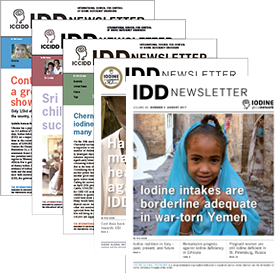Iodine Global Network (IGN)
Sprunglinks/Accesskeys
Zur Startseite (Accesskey 0) Direkt zur Hauptnavigation (Accesskey 1) Direkt zum Inhalt (Accesskey 2) Kontakt (Accesskey 3) Sitemap (Accesskey 4) Suche (Accesskey 5)
DONATE

#FutureFortified: How food fortification can help end micronutrient malnutrition
Download Summit Report and Recommendations:
Despite positive developments in reducing malnutrition over the last few decades, hundreds of millions of people globally still do not consume adequate amounts of essential vitamins and minerals in their diets to sustain good health and development. This is referred to as “hidden hunger,” a major public health problem that is holding back entire communities.
Those suffering from hidden hunger may not appear acutely malnourished, but may suffer the consequences of poor brain development, immune function, and work productivity. Especially within the first 1,000 days “window of opportunity” of a child’s life — from conception to the age of 2 — a lack of key micronutrients contributes to adverse physical and cognitive growth can have drastic, irreversible and lifelong impacts.
Communities also suffer from reductions in economic growth and a health care system overburdened by the medical treatment of preventable nutrition-related health problems.
Those suffering from hidden hunger may not appear acutely malnourished, but may suffer the consequences of poor brain development, immune function, and work productivity. Especially within the first 1,000 days “window of opportunity” of a child’s life — from conception to the age of 2 — a lack of key micronutrients contributes to adverse physical and cognitive growth can have drastic, irreversible and lifelong impacts.
Communities also suffer from reductions in economic growth and a health care system overburdened by the medical treatment of preventable nutrition-related health problems.
A proven, scalable and cost-effective nutrition intervention
Given this context, food fortification — the practice of adding small and safe amounts of micronutrients to staple foods and condiments — is a powerful nutrition success story that is reaching billions across the world. It is simple, scalable and among the world’s most cost-effective development interventions.The fortification of staples and condiments has been practiced in North America and Europe since the 1920s, and it has greatly contributed to the virtual eradication of diseases like pellagra, goitre, beriberi and scurvy.
But over the last decade, food fortification has gained global traction and its positive impact on the health of people in low- and middle-income countries is growing. More than 140 countries have national salt iodization programs, 85 mandate at least one kind of cereal grain fortification with iron and folic acid, and more than 50 mandate the fortification of at least one kind of edible oil and ghee with vitamin A. Important experience is now being accrued globally in reducing the prevalence of micronutrient deficiencies through fortification.
Despite this, many fortification programs require targeted and aligned efforts by government, the private sector, academia, consumer groups, international agencies and donors to ensure effective coverage, and in order to achieve optimal and sustained impact.
Toward a #FutureFortified
It was against this backdrop that the Global Alliance for Improved Nutrition and the Government of Tanzania hosted #FutureFortified, the 2015 Global Summit on Food Fortification, in Arusha, Tanzania, in September 2015. The aim of the event was to review achievements and challenges, understand the current evidence, and align ourselves with partners on the way forward.The event led to the Arusha Statement on Food Fortification, outlining priorities for the sector. Following the summit, a fortification Technical Advisory Group comprising more than 20 development agencies that are engaged in fortification, expanded on the five recommendations that emerged from the summit, including regulatory monitoring, evidence and guidelines, advocacy, resourcing and transparent reporting.
Possibly for the first time, all the major players in micronutrient fortification are today aligned around a common set of issues that need to be addressed. These issues are discussed in our new report The #FutureFortified Global Summit on Food Fortification:
 Event Proceedings and Recommendations for Food Fortification Programs
Event Proceedings and Recommendations for Food Fortification Programs , which summarizes the #FutureFortified global summit, and also provides new recommendations on how to improve food fortification programs.
, which summarizes the #FutureFortified global summit, and also provides new recommendations on how to improve food fortification programs.We are therefore in an unprecedented position to be able to deliver solutions together, which can lead to long-term impact in sustainable intakes of essential vitamins and minerals. In this way, we will have far-reaching effects on economies by improving overall physical health and, in due course, work productivity.
It is intended that this report will help implementing agencies, policymakers and donors, in particular, to improve coordination in the nutrition and food sectors.
This, in turn, will help expand, improve and sustain national fortification programs, and ensure that they help achieve public health objectives and relevant Sustainable Development Goals.
Greg S. Garrett is Director of Food Fortification at the Global Alliance for Improved Nutrition
